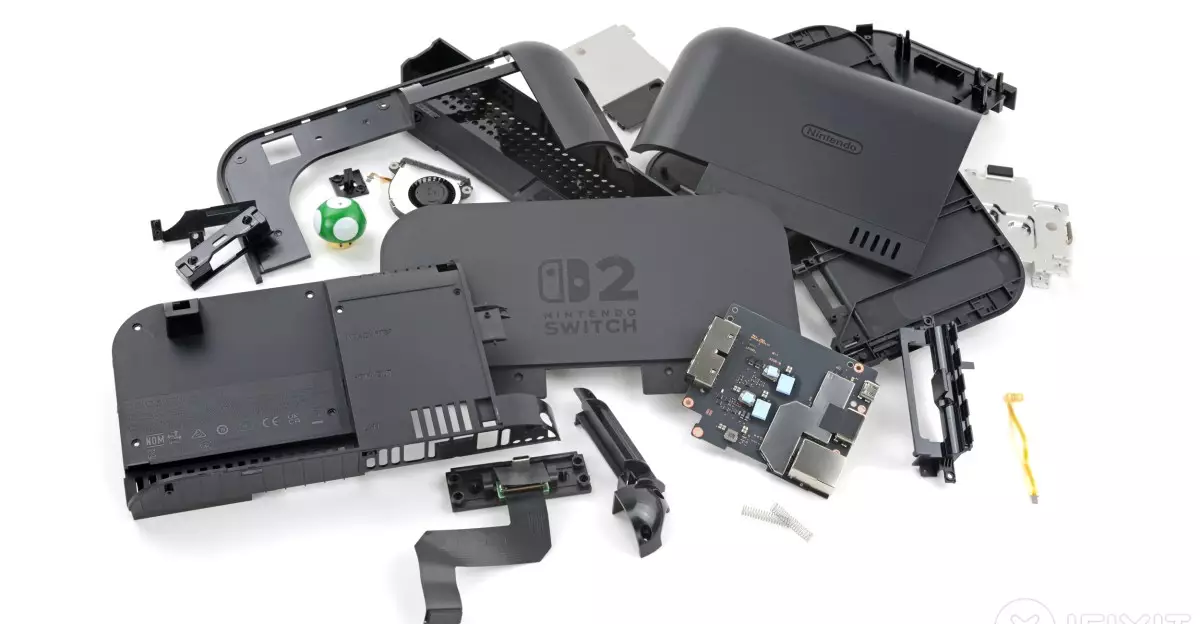Nintendo’s latest console iteration, affectionately dubbed the Switch 2, promises an enhanced gaming experience with its cutting-edge features and robust gaming library. However, beneath its modern facade lies a troubling reality regarding its repairability. With emerging insights from tech repair experts at iFixit following their detailed teardown, it’s become glaringly evident that Nintendo’s approach to device sustainability is regressive. The recent findings present a stark contrast to previous generations of the beloved device, raising questions about the company’s commitment to fostering a user-friendly ecosystem.
The repairability score—a crucial metric reflecting how easily a device can be fixed—was lowered significantly for the Switch 2, now sitting at a disappointing 3 out of 10. This deduction captures the essence of a console that is more challenging to maintain than its predecessors. A salient point in this analysis highlights that the Switch 2’s battery is ominously glued in place with strong adhesive, amplifying the difficulty of any potential repairs.
Nintendo’s Repair Culture: What’s at Stake?
Nintendo’s historical reliance on tri-point screws—a hallmark of many of its designs—serves both as a mark of its commitment to craftsmanship and as a barrier against easy repair. This design choice raises eyebrows, especially at a time when many tech companies are moving towards open designs that promote sustainability through repairability. By concealing screws behind fragile stickers, Nintendo has knowingly increased the likelihood of damage during disassembly, which contributes to an uninviting repair experience for users.
The lack of access to official repair parts, manuals, or even guidance magnifies this issue. This isn’t just an inconvenience; it’s a direct challenge to the principle of ownership over one’s device. Why should players be forced to depend on third-party solutions that may not meet the same quality standards? This approach fosters a scenario where users ultimately have two choices: they can either struggle through the repair process themselves or surrender their device to professionals, potentially at exorbitant costs.
What About the Components?
Taking a closer look at the internals reveals other components shrouded in solder and adhesive—a concept that’s becoming all too familiar in modern electronics. iFixit’s teardown unveiled that critical elements like the game card reader, once celebrated for its modularity, are now permanently affixed to the mainboard. This shift mirrors a concerning trend in the industry where convenience takes precedence over user empowerment. Such design alterations not only complicate fixes when hardware issues arise but also reduce the lifespan of the device over time, leaving gamers to wonder how feasible repairs will be as years wear on.
Compounding these repair challenges is the alarming revelation of three distinct types of thermal paste being utilized within the Switch 2, contrasting with the efficiency of older versions. This inconsistency not only complicates repairs but also poses potential risks regarding overheating—a concern that could harm gaming performance and longevity.
The Joy-Cons: A Mixed Bag
A pivotal aspect of the Nintendo gaming experience is undoubtedly the Joy-Cons. Unfortunately, even the latest batch appears less user-friendly. While the components such as the headphone jack and cooling fan retained their easier modular design for removal, the Joy-Cons have succumbed to the soldering craze as well, leading to standalone repairs becoming an arduous task. This is disheartening, especially given the fraught history surrounding joystick drift issues in previous iterations, which had often led to frustration among players.
The Joy-Cons are equipped with potentiometer technology that has caused durability issues in the past, leading to the infamous drift. By making repairs more difficult, Nintendo reduces users’ ability to address such problems proactively, potentially forcing a full device replacement instead of repair, an option aligned more with planned obsolescence than customer satisfaction.
In a market increasingly leaning toward sustainability and user-centric designs, Nintendo’s latest offering is a troubling reminder of how far the company has strayed from prioritizing the user experience in repairability. With rising awareness and criticism, hopefully Nintendo will take these insights to heart—after all, gaming should be as much about community and longevity as it is about innovation.

